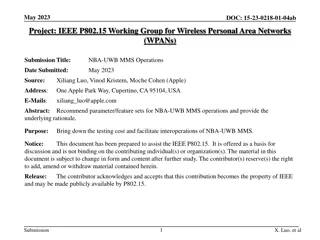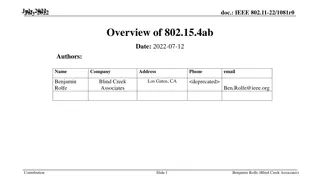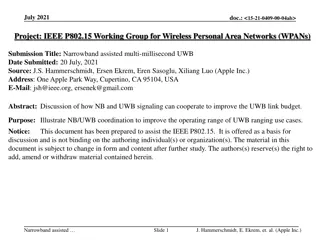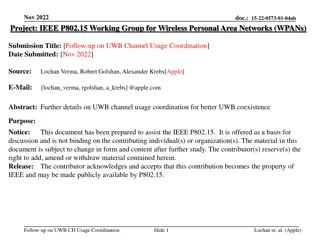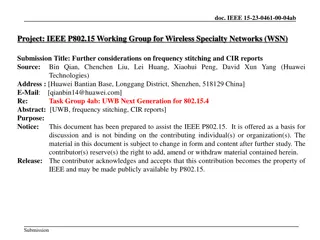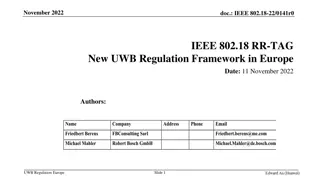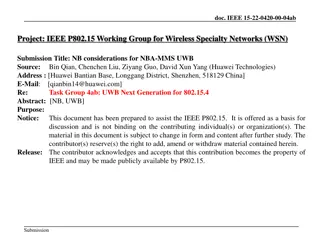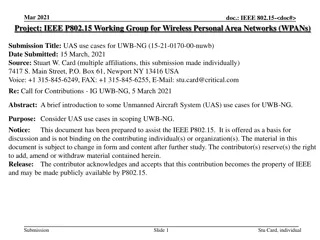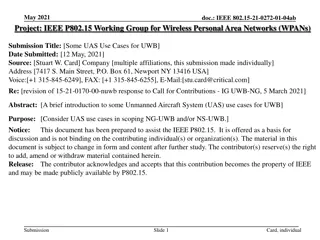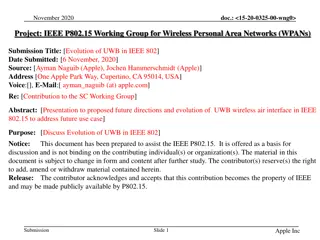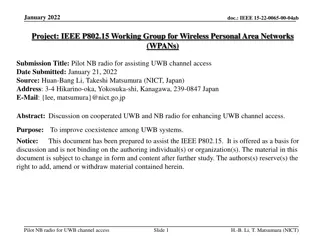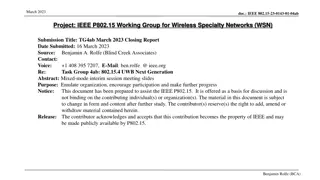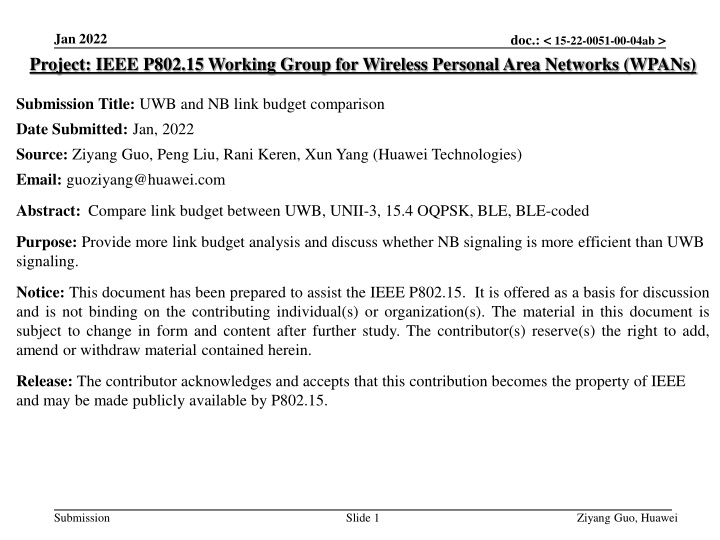
UWB vs NB Link Budget Comparison for Wireless Personal Area Networks
Explore the analysis comparing link budgets between UWB and NB signaling in the context of wireless personal area networks. The document delves into the efficiency of narrowband signaling compared to ultra-wideband signaling under various conditions, offering insights for IEEE P802.15 Working Group discussions.
Uploaded on | 4 Views
Download Presentation

Please find below an Image/Link to download the presentation.
The content on the website is provided AS IS for your information and personal use only. It may not be sold, licensed, or shared on other websites without obtaining consent from the author. If you encounter any issues during the download, it is possible that the publisher has removed the file from their server.
You are allowed to download the files provided on this website for personal or commercial use, subject to the condition that they are used lawfully. All files are the property of their respective owners.
The content on the website is provided AS IS for your information and personal use only. It may not be sold, licensed, or shared on other websites without obtaining consent from the author.
E N D
Presentation Transcript
Jan 2022 Project: IEEE P802.15 Working Group for Wireless Personal Area Networks (WPANs) doc.: < 15-22-0051-00-04ab > Submission Title: UWB and NB link budget comparison Date Submitted: Jan, 2022 Source: Ziyang Guo, Peng Liu, Rani Keren, Xun Yang (Huawei Technologies) Email: guoziyang@huawei.com Abstract: Compare link budget between UWB, UNII-3, 15.4 OQPSK, BLE, BLE-coded Purpose: Provide more link budget analysis and discuss whether NB signaling is more efficient than UWB signaling. Notice: This document has been prepared to assist the IEEE P802.15. It is offered as a basis for discussion and is not binding on the contributing individual(s) or organization(s). The material in this document is subject to change in form and content after further study. The contributor(s) reserve(s) the right to add, amend or withdraw material contained herein. Release: The contributor acknowledges and accepts that this contribution becomes the property of IEEE and may be made publicly available by P802.15. Submission Slide 1 Ziyang Guo, Huawei
Jan 2022 doc.: < 15-22-0051-00-04ab > PAR Objective Proposed Solution (how addressed) Safeguards so that the high throughput data use cases will not cause significant disruption to low duty-cycle ranging use cases Interference mitigation techniques to support higher density and higher traffic use cases Other coexistence improvement Backward compatibility with enhanced ranging capable devices (ERDEVs) Improved link budget and/or reduced air-time Additional channels and operating frequencies Improvements to accuracy / precision / reliability and interoperability for high-integrity ranging Reduced complexity and power consumption Hybrid operation with narrowband signaling to assist UWB Link budget analysis for UWB and how it compares with NB signaling schemes under different conditions Enhanced native discovery and connection setup mechanisms Sensing capabilities to support presence detection and environment mapping Low-power low-latency streaming Higher data-rate streaming allowing at least 50 Mbit/s of throughput Support for peer-to-peer, peer-to-multi-peer, and station-to- infrastructure protocols Infrastructure synchronization mechanisms Submission Slide 2 Ziyang Guo, Huawei
Jan 2022 doc.: < 15-22-0051-00-04ab > Narrowband assisted UWB - Overview UWB next generation task group (TG 4ab) is considering the definition of an NB PHY that is coupled to UWB PHY in order to assist it in various ways, for example, transmission offload or synchronization. Such a UWB+NB coupled operation requires a NB PHY range that is equal or higher than the next generation UWB PHY range. [1] proposed a new UWB transmit scheme aimed for increased UWB range that relies on synchronization assistance from a NB PHY but no range comparison analysis. [3] initiated a link budget comparison and suggested that current UWB PHY (BPRF mode) is more or less balanced with some candidate NB PHYs, but states that there is no decisive conclusion. [4] provided a link budget calculation at the end showing that an NB PHY will not necessarily meet the required range of a potential new generation UWB. Submission Slide 3 Ziyang Guo, Huawei
Jan 2022 doc.: < 15-22-0051-00-04ab > Purpose Analyze LM for ranging and LM improvement due to ranging preamble segmentation [1] Analyze LM for different SYNC PHY candidates, including NB and UWB PHYs Ranging Preamble SYNC Packet Frag 1 Frag 2 Frag 3 Frag N 1 2 3 N t/ms Time and Freq Sync Submission Slide 4 Ziyang Guo, Huawei
Jan 2022 doc.: < 15-22-0051-00-04ab > Link Margin Analysis for Ranging Where is link margin gain of ranging preamble segmentation from? Submission Slide 5 Ziyang Guo, Huawei
Jan 2022 doc.: < 15-22-0051-00-04ab > Link Margin Analysis for Ranging Tx Power: ?????? = ????????/?? + ? ???? ?? ?? + ?? ?? + ??[??] Rx Sensitivity: ?????? = ???????????/?? + ? ???? + ?? d? + ???????? Path Loss @1m: 2 4??? ? ??1?= ?? Link Margin: BO: backoff GG: gating gain (Tx power gain for short packets) PG: Processing Gain NF: noise figure ?? ?? = ?????? ?????? ??1? Submission Slide 6 Ziyang Guo, Huawei
Jan 2022 doc.: < 15-22-0051-00-04ab > Link Margin Analysis for Ranging PG (Processing Gain): ?? = 10log10(??) ?? denotes the number of pulses in ranging preamble GG (Gating Gain): ?? = 10log10(1?? ) ?? ?? denotes the preamble duration during 1ms GG is also known as power boosting gain due to distributing power to limited pulses Submission Slide 7 Ziyang Guo, Huawei
Jan 2022 doc.: < 15-22-0051-00-04ab > Link Margin Analysis for Ranging 7 CRB Bound of UWB pulse [7]: 6 5 ? RMS(d) ??? = 2 2?? ??? 4 RMS(cm) 3 where ? is effective bandwidth, W=533MHz for the IEEE 802.15.4z reference pulse [8] 2 1 0 0 5 10 15 20 25 30 SNR(dB) Supposing 2cm ragning accuracy, at least SNR=10dB is required In the LM calculation, assuming ??????= 10dB Submission Slide 8 Ziyang Guo, Huawei
Jan 2022 doc.: < 15-22-0051-00-04ab > Link Margin Analysis for Ranging configurations configurations Total preamble duration(us) Total preamble duration(us) N N cfg0 cfg0 960 cfg1 cfg1 960 cfg2 cfg2 960 cfg3 cfg3 960 cfg4 cfg4 960 cfg5 cfg5 960 NA 32 16 8 4 2 PRF(MHz) PRF(MHz) 64 64 64 64 64 64 Fragment Duration(us) Fragment Duration(us) NA 30 60 120 240 480 PSD(dBm/MHz) PSD(dBm/MHz) -41.3 -41.3 -41.3 -41.3 -41.3 -41.3 fc(Hz) fc(Hz) 7983000000 7983000000 7983000000 7983000000 7983000000 7983000000 B(Hz) B(Hz) 499200000 499200000 499200000 499200000 499200000 499200000 backoff(dB) backoff(dB) 1 1 1 1 1 1 NF(dB) NF(dB) 6 6 6 6 6 6 Processing Gain Processing Gain Preamble Duration Preamble Duration GG GG Ptx Ptx SNRmin(1.5cm@CRB) SNRmin(1.5cm@CRB) Prx Prx Path Loss Path Loss PL_1m PL_1m LM LM 47.88451207 47.88451207 47.88451207 47.88451207 47.88451207 47.88451207 0.00096 0.00003 0.00006 0.17728767 15.22878745 12.2184875 -15.1399666 -0.08846678 -3.09876674 -6.10906669 -9.11936665 -12.1296666 10 10 10 -71.0172542 -71.0172542 -71.0172542 -71.0172542 -71.0172542 -71.0172542 55.87728767 70.92878745 67.9184875 64.90818754 61.89788758 58.88758763 50.48509477 50.48509477 50.48509477 50.48509477 50.48509477 50.48509477 53.27670497 68.32820475 65.31790479 62.30760484 59.29730488 56.28700493 0.00012 9.20818754 6.197887583 3.187587626 0.00024 0.00048 10 10 10 Cfg0: conventional approach without preamble fragment Cfg1: N=32, Cfg2: N=16, Cfg3: N=8, Cfg4: N=4, Cfg5: N=2 Configurations refer to [2]. Submission Slide 9 Ziyang Guo, Huawei
Jan 2022 doc.: < 15-22-0051-00-04ab > Link Margin Analysis for Ranging 16 14 Lower than 18dB, stated in [2] LM improvement [dB] 12 10 8 6 4 2 0 32 16 8 4 2 Number of fragments LM can be boosted by preamble segmentation The LM improvement is all from Gating Gain, which is limited by regulation and power amplifier complexity Submission Slide 10 Ziyang Guo, Huawei
Jan 2022 doc.: < 15-22-0051-00-04ab > Link Margin Analysis for SYNC Packet Transmission How to pick the PHY for SYNC packet transmission to get a comparable LM with ranging? Submission Slide 11 Ziyang Guo, Huawei
Jan 2022 doc.: < 15-22-0051-00-04ab > Technologies of interest We would like to perform a link budget analysis for the following technologies: Technology UWB-0.85 UWB-6.8 UNII-3* OQPSK* BLE BLE-coded ?(MHz) 500 500 5 2 2 2 ?? (Mb/s) 0.85 6.8 1.625 0.25 1 0.125 ? is bandwidth, ?? is data rate. UNII-3 and OQPSK are NB radios proposed in [2]. The data rate of UNII-3 is calculated from Wi-Fi (20MHz, MCS0, 6.5Mb/s). Submission Slide 12 Ziyang Guo, Huawei
Jan 2022 Link Margin Analysis for SYNC Packet doc.: < 15-22-0051-00-04ab > Tx Power: ???[???] = ?????[???/??] + ?[????] ??[??] + ??[??] Rx Sensitivity: ?????? = ???????????/?? + ? ???? + ?? d? + ??? ?? ??? ?? =?? ?? ?????? = ???????????/?? + ?? ?? + ???????/??? +?? dB =???? ?0?[??] ?0[dB/bit] Link Margin: ?? ?? = ?????? ?????? ??1? BO: backoff GG: gating gain (Tx power gain for short packets) NF: noise figure Submission Slide 13 Ziyang Guo, Huawei
Jan 2022 Link Margin Analysis for SYNC Packet doc.: < 15-22-0051-00-04ab > According to FCC and CE regulations [5, 6], For OQPSK, BLE, BLE- coded, the maximum output power can go up to 20dBm. For UNII-3, the maximum output power for non- specific short-range device is 14dBm; If an adequate spectrum sharing mechanism (e.g., DFS and DAA) is implemented, the maximum output power can go up to 26dBm. LM of NB are larger than UWB. Parameters Parameters CC_rate CC_rate RS_rate RS_rate meanPRF(Hz) meanPRF(Hz) Ncpb Ncpb Tdsym Tdsym Nsync Nsync Nsfd Nsfd Tpsym Tpsym payload(bits) payload(bits) EbN0(dB) EbN0(dB) PSD(dBm/MHz) PSD(dBm/MHz) Output power(dBm) Output power(dBm) fc(Hz) fc(Hz) B(Hz) B(Hz) Backoff(dB) Backoff(dB) Noise figure(dB) Noise figure(dB) Rb Rb Td Td GG GG Ptx Ptx Prx Prx Path Loss Path Loss PL@1m PL@1m LM LM UWB(BPRF UWB(BPRF- -0.85) 0.85) 0.5 0.87 UWB(BPRF UWB(BPRF- -6.8) 6.8) 0.5 0.87 UNII UNII- -3 3 OQPSK OQPSK BLE BLE BLE BLE- -coded coded 15600000 15600000 16 2 1.02564E-06 1.28205E-07 64 64 8 8 9.9359E-07 9.9359E-07 160 3.5 160 3.5 1.5 8.5 8.5 4 -41.3 -41.3 -14.31725423 7983000000 499200000 -14.31725423 7983000000 499200000 14 10 10 10 5800000000 5000000 2450000000 2000000 2450000000 2000000 2450000000 2000000 1 6 1 6 1 6 1 6 1 6 1 6 848250 6786000 1625000 250000 1000000 125000 0.00030641 5.136966756 -10.18028748 -105.2147613 95.03447384 50.48509477 44.54937907 0.000100897 9.961197909 -5.356056325 -96.18386145 -104.3914663 -105.5205999 90.82780512 117.3914663 114.5205999 50.48509477 47.71033206 40.22509387 40.22509387 40.22509387 40.34271035 69.68113429 74.29550604 64.77490613 68.77490613 0 0 9 0 9 0 9 13 -96 105 -100 109 Submission Slide 14 Ziyang Guo, Huawei
Jan 2022 doc.: < 15-22-0051-00-04ab > Multipath Fading Effect For NB systems, 20dB multipath fading is assumed. Parameters Parameters Output power( Output power(dBm LM LM UWB(BPRF UWB(BPRF- -0.85) -14.31725423 44.54937907 0.85) UWB(BPRF UWB(BPRF- -6.8) -14.31725423 40.34271035 49.68113429 54.29550604 44.77490613 48.77490613 6.8) UNII UNII- -3 3 OQPSK OQPSK BLE BLE 10 BLE BLE- -coded coded dBm) ) 14 10 10 When multipath fading is considered, LM of NB using previous Tx power are comparable to UWB. Parameters Parameters Output Output power( LM LM UWB(BPRF UWB(BPRF- -0.85) -14.31725423 44.54937907 0.85) UWB(BPRF UWB(BPRF- -6.8) -14.31725423 40.34271035 61.68113429 64.29550604 54.77490613 58.77490613 6.8) UNII UNII- -3 3 OQPSK OQPSK BLE BLE 20 BLE BLE- -coded coded power(dBm dBm) ) 26 20 20 Increasing Tx power to the limit of regulations can further increase the LM of NB PHYs. Submission Slide 15 Ziyang Guo, Huawei
Jan 2022 doc.: < 15-22-0051-00-04ab > Summary LM for ranging is usually larger than that for data transmission and can be improved by preamble segmentation To obtain a comparable LM as ranging, NB PHYs for SYNC packet might be a good candidate, especially at LoS scenario Alternatively, other methods might be required to improve LM of UWB PHY for SYNC packet transmission, e.g., new channel coding Submission Slide 16 Ziyang Guo, Huawei
Jan 2022 doc.: < 15-22-0051-00-04ab > References 1. 2. 15-21-0605, Nba-mms-uwb-mac-considerations, Yong Liu et al (Apple Inc.) 15-21-0593, More on narrowband assisted multi-millisecond UWB, Ersen Ekrem et al (Apple Inc.) 15-21-0394, IR-UWB link budget analysis and how it compares with NB signaling, Koorosh Akhavan (Qualcomm Inc.) 15-21-0557, UWB Wakeup Signaling, Michael Mc Laughlin et al (Qorvo) FCC: Sec 15.247 ETSI: EN 300 328 D. Dardari et al, Ranging With Ultrawide Bandwidth Signals in Multipath Environments, Proceedings of the IEEE, vol. 97, no. 2, pp. 404-426, 2009 I. Domuta et al, Timestamp Estimation in P802.15.4z Amendment, Sensors, vol. 20, no. 18, 2020 3. 4. 5. 6. 7. 8. Submission Slide 17 Ziyang Guo, Huawei


